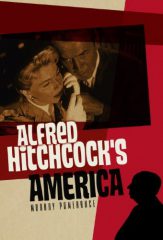With his second publication on Alfred Hitchcock, Professor Pomerance has now given focus to the Americanization of the great director’s themes and film settings. After all, Hitchcock remained British in character all of his life and probably had not imagined becoming an American subject in his early days.
 That things would turn out so well for him nobody could have foreseen, for when in 1938, he arrived in New York it was not certain that he would stay in the US. Only in 1955 did he officially attain American citizenship. Being an excellent cook and food connoisseur he, likewise, chose from the big variety of American humor, traits, and rich variety of individual mental attitudes towards life from almost all classes and commented on almost all aspects of American society.
That things would turn out so well for him nobody could have foreseen, for when in 1938, he arrived in New York it was not certain that he would stay in the US. Only in 1955 did he officially attain American citizenship. Being an excellent cook and food connoisseur he, likewise, chose from the big variety of American humor, traits, and rich variety of individual mental attitudes towards life from almost all classes and commented on almost all aspects of American society.
Aspects that for him – the stranger and long-time visitor – were observed and investigated with the routine and insight of a skilled modern anthropologist. Since he was also a great designer and arranger with an eye for detail, popular culture, dissonance and harmony, it is not surprising at all that the combination of those characteristics would make a great director.
And Hitchcock would investigate, try to analyze and comprehend the behavior, all those customs strange to him. For a “nosy” original British subject, the United States proved to be the perfect area to “collect data” in a way.
This in mind, it may be no coincidence that he named the movie he shot in 1955 “The Man Who Knew Too Much,” featuring a fantastic former jazz singer by the name of Doris Day.
Hitchcock until the late 1970s witnessed the development of city life, changing social relations (due to city life), modifications in family settings, the development of urban and suburban environments, and other major American themes; all of which were endangered by human traits found in every region of the world such as violence, greed, revenge and intrigue.
Let us not forget one of the main subjects of the book: a master of tension and mystery. His movies on another level deal with the transformation of spaces form modest farms and small suburbs to automated cities, the change from strong interpersonal relationships into modern and distanced models of existence and communities. Naturally, estrangement takes place there and many of the conflicts, occurrences and mean plots portrayed by Hitchcock are the result of estrangement and maladjustment as well as clashes between old and developing forms of American social relations.
Therefore, Pommerance argues, we see mostly uniquely American themes in Hitchcock’s American movies. Foreign Correspondent (1940), Saboteur (1942), Shadow of a Doubt (1943), Lifeboat (1944), Spellbound (1945), Notorious (1946), Rope (1948), Strangers on a Train (1951), Rear Window (1954), To Catch a Thief (1955), The Trouble With Harry (1955), The Man Who Knew Too Much (1956), The Wrong Man (1956; excellent but underrated Film Noir!), Vertigo (1958), North by Northwest (1959), Psycho (1960), The Birds (1963), Marnie (1964), Torn Curtain (1966) and Family Plot (1976).
Hence the book’s title, “Alfred Hitchcock’s America.”
Unlike a number of books about Hitchcock, this publication does not deal with movie after movie and trying to elaborate on plot and motive. Fortunately here we are introduced to the main themes of Pommerance’s analysis, and then presented with matching scenes and dialog from specific films. The chapters of the book deal with American spaces, personalities, values, social interaction and marriage in particular. This last chapter forms the most interesting section of the book.
We may not encounter the last book on the great director, but here we find a lot of interesting links between many movies from different decades. This may be the reason why we are not presented with a general conclusion at the end of the final chapter. However, this is not an academic book, so for supplying a first impression of how the master saw Americans deal with changes in their immediate environment and in their country, this book is quite useful.
Review by Dr. A. Ebert (2014)
Murray Pomerance. Alfred Hitchcock’s America (America Through the Lens). Polity Press, 2013, 324 p.
